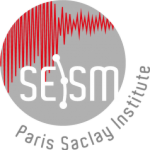
- Cet évènement est passé.
Soutenance de thèse de Luis Alvarez
18 11 2022 @ 10 h 00 min - 13 h 00 min
Nous avons le plaisir de vous inviter a la soutenance these de Luis Alvarez, bourse CIFRE EDF et co-tutelle avec l’Universite de Pavie, Italie.
Date: 18/11/2023
Lieu: UGE, Marne-la-Vallée, salle A016 a 10H.
le lien zoom pour la soutenance de these de Luis Alvarez:
Sujet : Luis Alvarez PhD defense
Heure : 18 nov. 2022 10:00 AM Paris
Participer à la réunion Zoom
https://univ-grenoble-alpes-fr.zoom.us/j/91559320942?pwd=YTJnRmM0NU9QY1o5aFlBQk52d2NGUT09
Improved 3D Ground Motion Simulation for Structural Response Analysis
Stochastic ground motion simulation methods represent an attractive alternative given the
shortage of recorded ground motion from moderate to large magnitude events recorded
in the vicinity of the seismic source, in particular when specific scenarios have to be
considered. Their popularity relies in the need of relative few numbers of parameters, a
comparatively simple formulation, and the successful examples when predicting the
ground motion from past events. All these characteristics render these methodologies
ideal for their application within an industrial context where computational times are more
constrained. Nevertheless, to confidently use these simulated ground motions in realistic
earthquake engineering applications, researchers and practitioners must exhaustively test
the simulation methodologies. This with the intention of providing clarity not only on the
thresholds of applicability of these techniques, but also on the possible bias that may be
introduced in the consideration of these in lieu of recorded ground motions.
This thesis introduces a new 3D stochastic ground motion simulation method, obtained
from the enhancement of state-of-the-art techniques available in the literature, and
considering complementary models aiming to improve the description of the source and
the spectral correlation structure of the simulated ground motions. First, the proposed
technique is described in detail and assessed by means of a sensitivity analysis aiming to
provide future users with a clear understanding of the simulation process and the overall
importance of each input considered in the model. The proposed technique is then further
evaluated by conducting a series of validations through seismological and earthquake
engineering applications. These validations were achieved through a series of case studies
assessing the capacity of simulated ground motions to describe the distributions of target
metrics, i.e., Intensity Measures (IMs), Engineering Demand Parameters (EDPs) and
Fragility curves derived from the response of simplified structural models, vis-à-vis those
obtained with real ground motions. These analyses were conducted with special regard to
the description of the variability related to the targeted metrics by modelling the epistemic
uncertainty associated to the input parameters. Additionally, the case studies were used to
showcase complementary procedures proposed for the calibration of the herein presented
methodology. Results indicated that, with an appropriate calibration, the proposed
simulation technique can reproduce the distributions of spectral accelerations and
significant durations expected for the considered earthquake case study. The most
accurate matching of the expected IMs distributions was found for simulations at short
distance from the source and considering stiff soils. Finally, the consideration of simulated
ground motion for the estimation of structural response shows almost negligible biases,
with respect to that obtained with recorded ground motions, when enforcing hazard
consistency in the distributions of IMs relevant for the considered EDPs.
The jury is composed by:
Adrian Rodriguez-Marek, Professor Virginia Tech University, Reporter
Fernando Lopez-Caballero, Professor Ecole CentraleSupelec, Reporter
Celine Gelis, Researcher IRSN, Examiner
Paola Traversa, Researcher EDF, Examiner
Philippe Gueguen, Senior researcher UGE/ISTerre, Examiner
Irmela Zentner, Researcher EDF, Co-supervisor
Gloria Senfaute, Researcher EDF, Co-superviror
Paolo Bazzurro, Professor Universite of Pavia, Co-director
Fabian Bonilla, Senior researcher UGE, Co-director
